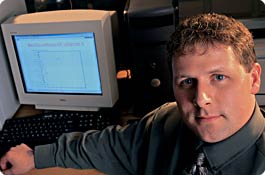Before Sept. 11, U.S. Army scientists at Fort Detrick, Md., tested about 10 samples a month of substances suspected as possible bioterrorism agents. Today, the Army reports, they test 700 samples in a single day.
MIDI Inc., a small biotechnology company in Newark, Del., is helping those scientists at the U.S. Army Medical Research Institute of Infectious Disease (USAMRIID) quickly identify potential bioterrorism agents. Craig Kunitsky ’94 is MIDI’s global technical marketing manager.
MIDI’s Sherlock® Microbial Identification System also was used by the Connecticut Department of Public Health to confirm, in fall 2001, that 94-year-old Ottilie Lundgren was indeed infected with anthrax.
“Each bacterium has a signature fatty-acid pattern which is a compound in the cell membrane–think of it as a fingerprint,” Kunitsky explains. “We grow the bacteria on a plate, use a simple extraction procedure to free up the fatty acids, and then run it through a gas chromatograph. Once the pattern comes out we compare it to our database of known strains. Right now we have 18,000 entries in our database.”
Kunitsky says that although MIDI had developed the database by January 2001 and was, in fact, offering it at no charge, “we were having trouble giving it away” until last fall’s anthrax incidents. “Right now we’re involved in a number of exciting things, including developing the first mobile chemical and biological laboratory,” says Kunitsky. “It’s housed in a van and can be driven anywhere in a city to do sampling. The first one was delivered to a major metropolitan area on March 17.”
This spring, MIDI is also introducing a new software program, the Sherlock® Tracker System. “Once we’ve identified the bacterium, the next part is finding out where it came from,” Kunitsky says. “The tracker system looks at thousands of strains in minutes–as opposed to the weeks it takes with current methods.”
Quicker Response Time
The Sherlock® Tracker System reflects MIDI’s increasing focus on epidemiology. “If a group of hospitals or public health departments are linked with our system, for example, and a strange bug shows up in one area, they can send the information to one database and quickly see if the same thing is occurring elsewhere, find the source, and contain it,” Kunitsky says.
Kunitsky, a chemical engineering graduate, is directly involved in many of these new projects. He maintains the web site, writes technical manuals, oversees marketing, helps with graphics, and develops presentations for customers. Perhaps most important, Kunitsky is the interface between the software engineers and the microbiologists in the lab testing the samples. “I help each group understand what’s going on. It’s key that I’m able to move quickly from one area to the next and rapidly adapt. My work requires good communication skills, which I initially developed at Lafayette as part of my liberal arts education,” he says.
Kunitsky earned a master’s in biomedical engineering from University of Virginia and an M.B.A. from University of Delaware, during which time he began working for MIDI as a corporate associate. He became full-time after completing his degree. Kunitsky works with MIDI clients ranging from the U.S. Defense Department and Centers for Disease Control to state public health departments and major pharmaceutical companies. “A lot of our work is for pharmaceutical companies, testing formulations to see if there are any bacterial contaminants,” he says.
Two years ago, MIDI signed an agreement with USAMRIID to build a database of six main bioterrorism bacteria including anthrax and the plague. “All these agents are diseases of animals and a lot are more prominent in tropical regions,” Kunitsky says. “The scary part is that many were developed by the Soviet Union and placed in warheads. Now, after the Cold War, some of this stuff is in stockpiles, and who knows who has it. Developing communication networks is critical in dealing with a bioterrorism threat. If there were a big attack, identifying the source in hours versus days would be crucial to saving many lives.”
Saving Lives
As a student at Lafayette, Kunitsky had initially thought about saving lives as a doctor and had seriously considered medical school.
“I was good at math and science, and although I was interested in medicine I was also interested in engineering,” he says. Working at DuPont made him realize he didn’t want to be in a lab all the time. Then he discovered biomedical engineering. “At the University of Virginia I worked on developing a better pacemaker and making drugs more efficient.”
Kunitsky says his experience as a teaching assistant and other opportunities made possible at a smaller institution gave him “invaluable interpersonal communication skills.” Although excited about the many new directions MIDI is exploring, Kunitsky is especially proud of the new tuberculosis identification system, currently undergoing the Food and Drug Administration approval process. “It will make testing so inexpensive that hospitals and clinics can do more samples and more routine screening,” he says. “That’s important because eight million people died of TB in the last year–it’s the leading cause of death in the world. One in three people have TB. A technique for looking at patterns manually has been around for years but we’ve automated it.”

Craig Kunitsky '94
